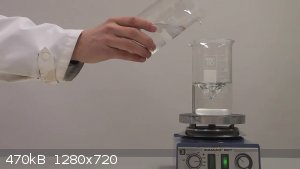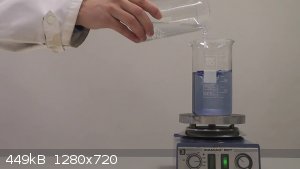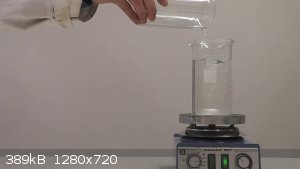| Pages:
1
2 |
Doktor Klawonn
Harmless

Posts: 29
Registered: 20-11-2010
Location: Europe
Member Is Offline
Mood: No Mood
|
|
chemistry riddle
Greetings,
inspired by a post from a user on versuchschemie.de I tried this experiment. It's a chemical riddle.
A colorless liquid is poored into another colorless liquid in a beaker. On addition the liquid turns blue. Eventually on further addition the liquid
turns colorless again.
  
Do you know how it is done? Have fun finding it out!
Dr. K.
P.S.
I uploaded a video of this experiment to my youtube-channel: https://www.youtube.com/watch?v=CILOKdjAvk4
[Edited on 17-1-2015 by Doktor Klawonn]
|
|
|
Zombie
Forum Hillbilly
    
Posts: 1700
Registered: 13-1-2015
Location: Florida PanHandle
Member Is Offline
Mood: I just don't know...
|
|
I would venture the guess that it is a chemical reaction in the beginning, and a thermal reaction at the end.
Just an uneducated guess.
They tried to have me "put to sleep" so I came back to return the favor.
Zom.
|
|
|
macckone
Dispenser of practical lab wisdom
    
Posts: 2168
Registered: 1-3-2013
Location: Over a mile high
Member Is Offline
Mood: Electrical
|
|
Looks similar to the blue bottle reaction.
|
|
|
Doktor Klawonn
Harmless

Posts: 29
Registered: 20-11-2010
Location: Europe
Member Is Offline
Mood: No Mood
|
|
The blue bottle is a nice experiment. However, this reaction has nothing to do with it.
[Edited on 18-1-2015 by Doktor Klawonn]
|
|
|
unionised
International Hazard
    
Posts: 5128
Registered: 1-11-2003
Location: UK
Member Is Offline
Mood: No Mood
|
|
A way to do it would be to put starch /KI in dilute acid in the beaker and add a solution of an oxidant in dilute alkali.
Initially the oxidant converts the iodide to iodine which gives a blue colour.
Further addition neutralises the acid and then makes the solution alkaline causing the iodine to disproportionate so the colour is removed.
There are probably other possibilities.
[Edited on 18-1-15 by unionised]
|
|
|
Brain&Force
Hazard to Lanthanides
    
Posts: 1302
Registered: 13-11-2013
Location: UW-Madison
Member Is Offline
Mood: Incommensurately modulated
|
|
I would agree with unionised that the reaction involves iodine, but I think it might be going iodide > triiodide-starch complex > iodate.
At the end of the day, simulating atoms doesn't beat working with the real things...
|
|
|
HgDinis25
Hazard to Others
  
Posts: 439
Registered: 14-3-2014
Location: Portugal
Member Is Offline
Mood: Who drank my mercury?
|
|
Maybe a pH indicator. It startes out colorless (either in an acidic or basic medium, depending on the indicator). You add an acid or a base and it
turns blue. And when the medium becames too acidic/basic it goes colorless again. I don't know any indicator that does this, what so ever... A Redox
indicator could work in the same lines too...
|
|
|
Doktor Klawonn
Harmless

Posts: 29
Registered: 20-11-2010
Location: Europe
Member Is Offline
Mood: No Mood
|
|
No iodine or starch are included. The liquids are of room temperature.
|
|
|
Zombie
Forum Hillbilly
    
Posts: 1700
Registered: 13-1-2015
Location: Florida PanHandle
Member Is Offline
Mood: I just don't know...
|
|
I beg to differ... I see the heat control on the hot plate is active. Thus my initial answer stands.
There is a chemical reaction that depends on a specific temp., and as the addition continues (cooler compound), that temp fell to negate the reaction.
What is this "room temp" witchery of which you speak?
They tried to have me "put to sleep" so I came back to return the favor.
Zom.
|
|
|
phlogiston
International Hazard
    
Posts: 1379
Registered: 26-4-2008
Location: Neon Thorium Erbium Lanthanum Neodymium Sulphur
Member Is Offline
Mood: pyrophoric
|
|
No, the heat control is off. Notice the left switch (heater) is not lit. The right switch (stirrer) is on.
-----
"If a rocket goes up, who cares where it comes down, that's not my concern said Wernher von Braun" - Tom Lehrer |
|
|
Zombie
Forum Hillbilly
    
Posts: 1700
Registered: 13-1-2015
Location: Florida PanHandle
Member Is Offline
Mood: I just don't know...
|
|
Well then color me blind. I'm out.
They tried to have me "put to sleep" so I came back to return the favor.
Zom.
|
|
|
The Volatile Chemist
International Hazard
    
Posts: 1981
Registered: 22-3-2014
Location: 'Stil' in the lab...
Member Is Offline
Mood: Copious
|
|
Sugar, potassium hydroxide, and a blue indicator similar in qualities to phenolphthalein?
Just an 'uneducated guess' 
|
|
|
Zombie
Forum Hillbilly
    
Posts: 1700
Registered: 13-1-2015
Location: Florida PanHandle
Member Is Offline
Mood: I just don't know...
|
|
One more guess... Copper Sulfate / Sulfuric Acid on the stir'er. and Potassium Hydroxide is the addition.
Copper hydroxide is the blue precipitate.
They tried to have me "put to sleep" so I came back to return the favor.
Zom.
|
|
|
Doktor Klawonn
Harmless

Posts: 29
Registered: 20-11-2010
Location: Europe
Member Is Offline
Mood: No Mood
|
|
Wow, from your guesses alone one could make a bunch of interesting experiments. I am impressed.
No sugar, no copper sulfate. Two hints:
1. The temperature actually is rising a little (2-5 °C).
2. You can perform the experiment in colors like yellow or pink as well.
|
|
|
CuReUS
National Hazard
   
Posts: 928
Registered: 9-9-2014
Member Is Offline
Mood: No Mood
|
|
clock reaction or complex formation
http://en.wikipedia.org/wiki/Chloropentamminecobalt_chloride
|
|
|
gdflp
Super Moderator
      
Posts: 1320
Registered: 14-2-2014
Location: NY, USA
Member Is Offline
Mood: Staring at code
|
|
Okay, my guess. The beaker being stirred contains a base such as sodium hydroxide. The liquid you are adding is a solution of an excess of dilute
acid and some thymolphthalein. When a small amount is added, the solution is still basic and it turns a bluish color. When more solution is added,
the pH turns acidic and the thymolphthalein becomes colorless. Substituting the thymolphthalein for phenolphthalein will be the same experiment, but
it will be colorless-pink-colorless instead. I'm not sure what would provide a yellow color.
|
|
|
Doktor Klawonn
Harmless

Posts: 29
Registered: 20-11-2010
Location: Europe
Member Is Offline
Mood: No Mood
|
|
@gdflp: Yes, you are right. This is the perfect explanation. As for the yellow color, one could use nitrophenole. Mixing thymolphthaleine and
nitrophenole would give a green variant of this experiment.
regards
Dr. K.
|
|
|
Hegi
Hazard to Others
  
Posts: 199
Registered: 27-9-2013
Member Is Offline
Mood: No idea.
|
|
What is funny about this is the fact that everyone came up with those much more difficult possibilities than acid-base reaction with the indicator -,-
 We were not expecting it! We were not expecting it! 
Our webpage has been shut down forever cause nobody was willing to contribute. Shame on you all!!!
|
|
|
CuReUS
National Hazard
   
Posts: 928
Registered: 9-9-2014
Member Is Offline
Mood: No Mood
|
|
Quote: Originally posted by Hegi  | What is funny about this is the fact that everyone came up with those much more difficult possibilities than acid-base reaction with the indicator -,-
 We were not expecting it! We were not expecting it!  |
someone already guessed that it was a pH indicator
Quote: Originally posted by HgDinis25  | | Maybe a pH indicator. It startes out colorless (either in an acidic or basic medium, depending on the indicator). You add an acid or a base and it
turns blue. And when the medium becames too acidic/basic it goes colorless again. I don't know any indicator that does this, what so ever...
|
but the iodine disproportionation idea was brilliant,really really smart to think of such a thing 
Quote: Originally posted by unionised  | A way to do it would be to put starch /KI in dilute acid in the beaker and add a solution of an oxidant in dilute alkali.
Initially the oxidant converts the iodide to iodine which gives a blue colour.
Further addition neutralises the acid and then makes the solution alkaline causing the iodine to disproportionate so the colour is removed.
|
[Edited on 20-1-2015 by CuReUS]

|
|
|
Etaoin Shrdlu
National Hazard
   
Posts: 724
Registered: 25-12-2013
Location: Wisconsin
Member Is Offline
Mood: Insufferable
|
|
I figured the blue was thymolpthalein but was assuming it was in the stirred beaker and couldn't think of a mechanism. Just goes to show.
|
|
|
phlogiston
International Hazard
    
Posts: 1379
Registered: 26-4-2008
Location: Neon Thorium Erbium Lanthanum Neodymium Sulphur
Member Is Offline
Mood: pyrophoric
|
|
There is one thing that does not seem to fit with this explanation (pH indicator+dilute acid)
If you observe the video, you can see that the first additions are poured into the vortex and give rise to a faint blue color in the vortex which
dissapears upon mixing. Only when a critical amount of liquid has been added does the color stay (as is commonly observed in titrations).
If it was an indicator+acid added to an alkaline solution, you would expect to see initially a relatively strong color in the vortex which is diluted
but persists upon mixing, and not a critical treshold.
-----
"If a rocket goes up, who cares where it comes down, that's not my concern said Wernher von Braun" - Tom Lehrer |
|
|
gdflp
Super Moderator
      
Posts: 1320
Registered: 14-2-2014
Location: NY, USA
Member Is Offline
Mood: Staring at code
|
|
I did too! It was bothering me how that was possible until I had that "duh!" moment.
Quote: Originally posted by phlogiston  | There is one thing that does not seem to fit with this explanation (pH indicator+dilute acid)
If you observe the video, you can see that the first additions are poured into the vortex and give rise to a faint blue color in the vortex which
disappears upon mixing. Only when a critical amount of liquid has been added does the color stay (as is commonly observed in titrations).
If it was an indicator+acid added to an alkaline solution, you would expect to see initially a relatively strong color in the vortex which is diluted
but persists upon mixing, and not a critical threshold. |
If you watch carefully, it never really loses the blue color entirely, I think it appears this way because the thymolphthalein is so dilute in the
acid, it is not noticeable when only a small amount of the solution is poured in. As more of the acid is poured in, the concentration of
thymolphthalein starts rising to a point where it becomes noticeable. The appearance of a critical point may just be due to the solution being poured
in quickly and not being thoroughly mixed quick enough.
|
|
|
Pickardjr
Harmless

Posts: 45
Registered: 27-5-2013
Member Is Offline
Mood: vapor state
|
|
The Chem professer did this one, cant remember what he called it, something like a chemical time clock. The reaction would change colors and then back
again just like clock work at specific time intervals. Don't know if thats what it is.
|
|
|
Molecular Manipulations
Hazard to Others
  
Posts: 447
Registered: 17-12-2014
Location: The Garden of Eden
Member Is Offline
Mood: High on forbidden fruit
|
|
A clock reaction usually goes in one direction, like the iodine clock reaction. It can be calibrated to change colors at the time the chemist wants, by adjusting the quantity of the limiting reactant,
like a clock.
An oscillating reaction also goes in one direction, but when one reactant (generally the one or one of the ones responsible for the color) gets to a
high enough concentration, it reacts again and goes back to the original color or lack thereof. This happens until the limiting reactant runs out,
which allows quite a few "oscillations". It appears to oscillate, but is in fact not really going backwards, otherwise, what would keep it from going
forever? An actual oscillating reaction cannot happen.
[Edited on 2-2-2015 by Molecular Manipulations]
-The manipulator
We are all here on earth to help others; what on earth the others are here for I don't know. -W. H. Auden
|
|
|
woelen
Super Administrator
        
Posts: 8027
Registered: 20-8-2005
Location: Netherlands
Member Is Offline
Mood: interested
|
|
Indeed, true oscillation is not possible in chemistry. One of the reactants is the 'driving force' and as soon as that is depleted, the
oscillation-like behavior stops and a steady state situation is reached.
It can be compared with a relaxation oscillator from electronics, as long as the source of charge is working (e.g. a power supply) the relaxation
oscillator still works, but when the source of charge becomes depleted, the 'oscillations' become slow and finally come to an end.
http://woelen.homescience.net/science/physics/exps/relaxatio...
The principle behind the 'oscillators' mentioned on this webpage are the same as the ones, driving chemical 'oscillators'.
|
|
|
| Pages:
1
2 |